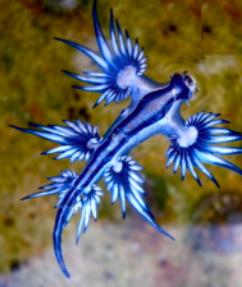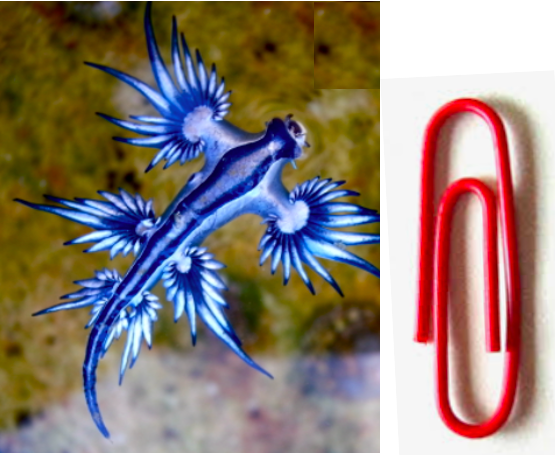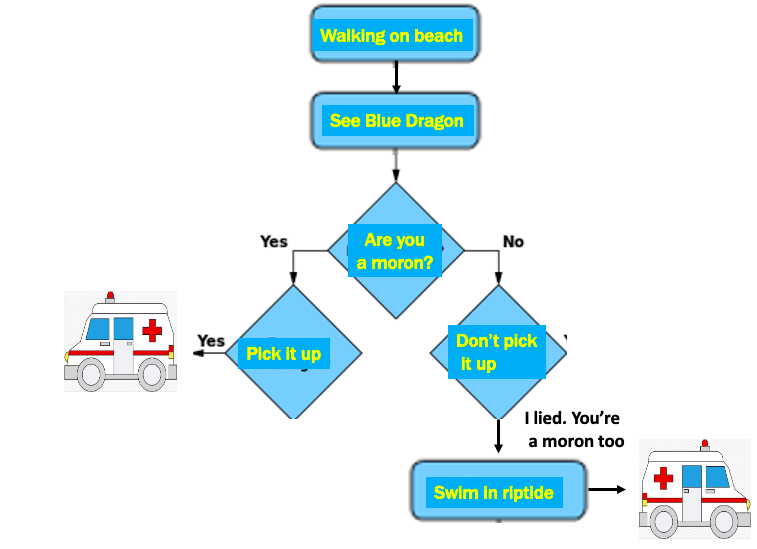
In recognition of the upcoming summer, can there possibly be a better way to celebrate than scaring the hell out of any of you who may be on the fence about swimming in the ocean? I think not.
As I wrote last year, blue is usually a color to be avoided when you're jumping the waves. One example is the bluefish because of its vicious bite, which is legendary. And their temperament ain't so great either. Here are a few quotes from The Outdoor Website.
- "If they had a taste for human flesh, no one would go swimming."
- "Mangled fingers cut to the bone will be your souvenir for a careless hook extraction."
- "True or not, bluefish seem to bite with purpose."

Photo: Wikipedia
But it gets worse
Driven by wind and currents, the Portuguese Man-of-War is both repulsive and dangerous. It is one of the last things, with the possible exception of a Mark 37 torpedo, that you'll ever want to see heading at you in the water. And the damn thing isn't that easy to avoid. Sure, the characteristic blue balloon is a dead giveaway, but should you be swimming underwater, you could run into a tentacle, especially since they can be 160 feet long - half the length of a football field. And the sting, although not the worst, is still legendary.

(Left) A Portuguese Man-of-War. One reason house prices are soaring in Arizona. Photo: Flickr (Right) Gladys, who should have stayed home and played mahjong, contemplates two lamentable choices. Original photo: Wunderstock
And worse
If you think getting stung by one of these floating monstrosities is bad, imagine eating one. Worse still, imagine eating one pretty much every day. But, in today's "Ain't Life Strange" feature, we meet a (thankfully) rare ocean dweller that puts the M-O-W to shame. It is called Glaucus atlanticus, aka the blue dragon – just one more denizen of the sea that we could cheerfully do without. And a bunch of them recently washed up on a beach in Texas. Yuck.

The Glaucus atlanticus, aka blue dragon. Despite a fleeting resemblance to RuPaul, they are quite different; the blue dragon is only one inch long – about the same size as a paper clip. They are gastropods, just like snails and clams, but lack a shell. It is also referred to as a "sea snail" or "sea slug." Photo: Wikimedia Commons.
The Blue Dragon is Blue (Duh). Because It Eats Portuguese Man-of-War. Yum!
If some life form feasts upon Man-of-War (1), it must have some reason for doing so (unlike humans, who voluntarily eat kale). In fact, it has a very good reason – one that also explains its color. The blue dragon eats the M-O-W jellyfish (2) and absorbs and stores the poisonous venom, giving it a pretty good defense system.
Other Moderately Useless Facts About the Blue Dragon
- They float upside down on the ocean's surface, their blue belly facing upward as camouflage, blending in with the color of the ocean and protecting it from predators from above. A bubble of air in its belly keeps the hideous thing upside down (as if the stupid thing knows the difference).
- It also has a silvery/gray back, which faces down as camouflage to protect it from predators below.
- Cutting to the chase, this heinous abomination spends its wretched time on earth floating around upside down, trying not to be eaten, while searching for its own disgusting meal - a Portuguese Man-of-War.
- Nice life.
- [Writer's comment] In my opinion, this is a good example of bio-presumptuousness. This idiotic thing has gone through a whole lot of trouble evolving ways to protect itself. But why? As if creatures above and below are breathlessly lining up (picture an all-you-can-eat Las Vegas buffet) just for the privilege of dining on a floating, poisonous one-inch piece of vileness.
- When they eat the Man-of-War, it concentrates the venom so that its sting is actually significantly worse than that of the M-O-W. This is bad.
- How bad? According to the Center for Surf Research, a single sting can cause vomiting, severe pain, nausea, papules, redness, and fluid-filled blisters.
- When the mood strikes them, blue dragons sometimes eat each other, something that can only make them even more endearing.
What to do if you encounter one
This can be best expressed by the following flow chart:

So I hope you folks in warmer waters enjoy your summer. I'm OK for now. The ocean temperature on Long Island today is a scrotum-shriveling 48°F. No thanks.
NOTES:
(1) There are several animals that eat jellyfish, including turtles.
(2) Despite its appearance and sting, the Portuguese Man-of-War is not a jellyfish, although it is closely related to them. Instead, it is a colony of tiny, individual organisms called zooids.



